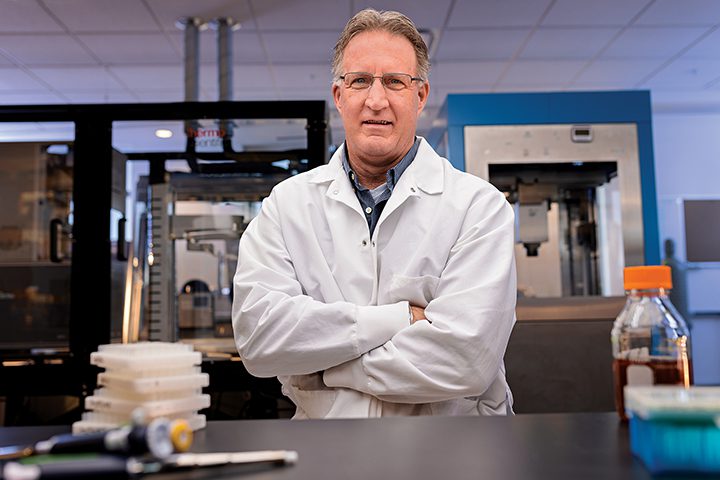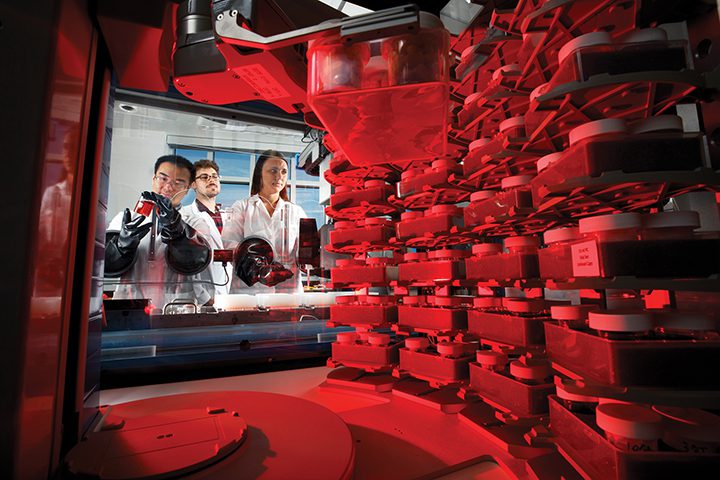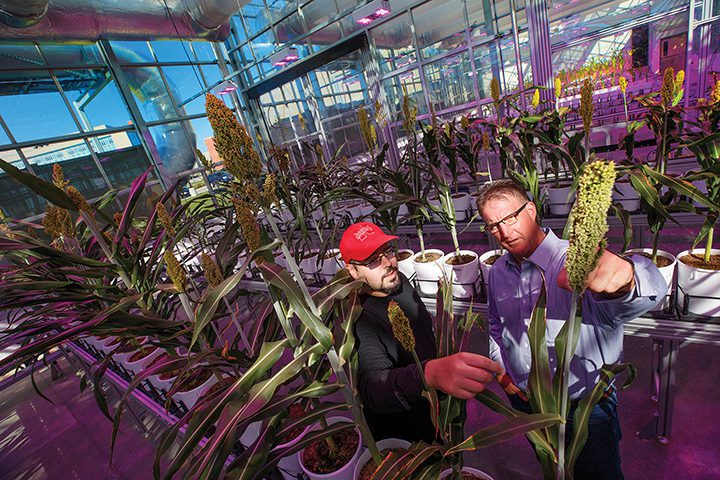Nebraska Researchers Study the Connections Between Food Production and Human Health
By Geitner Simmons, IANR Media
This story has been adapted from the original for this publication.
We live in a microbial world. From door handles to escalator handrails and even fermented foods, we come into contact with a wide range of bacteria, viruses and fungi on a daily basis. Our bodies are also home to trillions of microbes, particularly in the colon where the numbers of microbes outnumber cells in our bodies by at least a factor of 10.
And their impact is vast. The gut microbiome — a term that encompasses the collection of microbes and their functions in an ecosystem, such as the gut— is primarily impacted by what we eat and affects everything from our digestive health to cardiovascular health, immune health and maybe even our moods. These microbes are so impactful, in fact, that some researchers consider them to be a separate organ, which shapes our metabolism, our susceptibility to allergic and inflammatory diseases and even our responses to medical treatments.
At the University of Nebraska–Lincoln, in collaboration with the University of Nebraska Medical Center, scientists are conducting extensive research of the microbiome to find the links from agriculture and food production to human wellness and the prevention of disease.
Located at the Nebraska Innovation Campus, the multidisciplinary Nebraska Food for Health Center brings together strengths in agriculture and medicine from throughout the University of Nebraska System.
The center helps develop hybrid crops and foods to improve the quality of life of those affected by feeding the gut microbes as well as the human host. The approach is aimed at reducing susceptibility to critical diseases, such as heart disease, diabetes, obesity and inflammatory bowel disease.
Recently, UNL researchers identified specific traits in sorghum that contribute to a healthy gut microbiome. This groundbreaking discovery paves the way for identifying additional traits in sorghum and other food crops that have the potential to improve human health, as well as for the emergence of new crop varieties developed with health of the microbiome and the human host in mind.
The researchers’ findings were published in the journal Nature Communications, a significant milestone for the Nebraska Food for Health Center. The lead investigator was Qinnan Yang, a postdoctoral researcher from NFHC and the UNL Department of Food Science and Technology. Other Husker scientists contributing to the project were Andrew K. Benson, the paper’s corresponding author, and co-authors Mallory Van Haute, Nate Korth, Scott E. Sattler, John Toy, Devin J. Rose and James C. Schnable.
Among their findings, the researchers identified segments on nine sorghum chromosomes where genetic variation produces significant effects on the microbiome’s fermentation activity. On two of the chromosomes, scientists ultimately found an important connection between sorghum genes for seed color, tannin presence in sorghum seed and effects of the tannins on desirable organisms in the microbiome.


Identifying seed traits that encourage growth of desirable bacteria is medically significant because these species of microbes are associated with major health benefits, including reduced susceptibility to inflammatory bowel disease and certain metabolic diseases.
“Now that we’ve shown plant genes can control changes in the human gut microbiome, we can use our approach to screen hundreds or thousands of samples of different crops,” Yang said. “That makes it possible for plant breeding programs to harness natural genetic variation in crops to breed new crop varieties that improve human health by promoting beneficial bacteria in the human gut.”
For this project, Nebraska Food for Health Center scientists used techniques that duplicated the human body’s digestive and gastrointestinal activity and screened nearly 300 different sorghum lines using a miniaturized, automated methodology called automated in vitro microbiome screening (AiMS). At present, Nebraska’s Institute of Agriculture and Natural Resources is the only academic institution in the world using the innovative AiMS technology for seed-trait/microbiome analysis.


The concept for the AiMS methodology “was nothing more than a pipe dream six years ago. Now, it’s turned into reality,” said Benson, director of the Nebraska Food for Health Center and the Nebraska Food for Health Presidential Chair in the Department of Food Science and Technology.
The AiMS methodology stands out for its versatility. Researchers can study the microbiome activity of healthy human participants and those with health challenges. They can study the gut metabolism of humans and animals, and the seed trait studies can analyze the microbiome effects from any food crop.
“It’s really a powerful technology,” Benson said. “The sky’s the limit on this.”
These steps forward are a fulfillment of the vision that has powered the Nebraska Food for Health Center from its beginning, starting with a set of white papers Benson and Robert Hutkins, a fellow professor of food science and technology, drew up in 2006 and 2007. A new DNA sequencing technology was commercialized in 2006, they wrote, and the university needed to think strategically about how it could use those new sequencing tools to achieve major research contributions.
In subsequent years, IANR faculty and administrators followed up on that vision through strategic discussions, investments in infrastructure and new faculty hires. This ultimately led to launch of the Nebraska Food for Health Center in 2016 and development of AiMS facilities for food trait and microbiome research at Nebraska Innovation Campus. NFHC was fueled by key philanthropic and Husker investments, which expanded ongoing transdisciplinary collaboration.
The Nature Communications paper is the start of a new stage of discovery at the Nebraska Food for Health Center.
The paper “is sort of at the front end,” Benson said. “The joy now is to see how what we discover translates to the rest of the center … and the great thing is that we have the collaborative researchers who are there to do it.”
“They’re just waiting,” Benson said, to carry on important follow-up projects and analysis.
All these developments, he said, “resonate back to 2006 and 2007, when we said, ‘Gee, what if …’ Now, here we are, actually trying to do it.”










